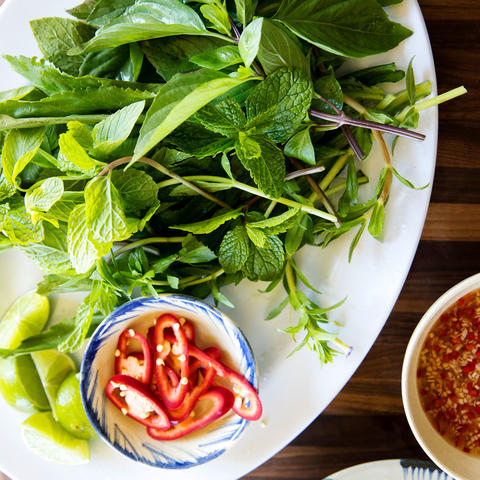Garnish Plate for Pho

- Preparing Time: -
- Total Time: -
- Served Person: Serves 2
- 1 lime, cut into wedges
- 2 handfuls (about 3 oz | 90 g) bean sprouts
- 2 or 3 sprigs mint, regular or spicy
- 2 or 3 sprigs thai basil
- 3 or 4 fresh culantro leaves
- 2 or 3 sprigs rice paddy herb
- 1 thai chile or 1/2 jalapeã±o, fresno, or serrano chile, thinly sliced
Preparation If you’re blanching the bean sprouts, work it into the pho assembly process and use the pot set up for dunking noodles; the noodle strainer is perfect for the job. Blanch them before starting on the noodles to avoid giving them a starch bath, and put them on their own plate so they don’t leak water on other garnishes. Otherwise, arrange the raw sprouts with the herbs and lime on a communal plate. If the chile is small, cut it at a sharp angle to yield largish slices that can be easily identified in the bowl. Put the slices in a little dish so they don’t get lost. Before bowl assembly, set the garnishes at the table with any other sides and condiments so you can dive in immediately. Hot Chile TipsFresh hot chiles don't always deliver their spicy punch because of factors like weather. When it’s cold outside, they have less oomph, so add extra to your pho bowls and dishes. Be careful during the summer months when their heat is on. Most of a chile’s heat is contained in the capsaicin glands (membranes) attached to the seeds. Enjoy slices close to the stem if you’re a heat seeker. During prep, use the cut stem end to scoot chile pieces onto a knife blade and push them into wherever they’re needed. Wash hands with coarse salt, if you touch a chile’s cut surfaces. From The Pho Cookbook: Easy to Adventurous Recipes for Vietnam's Favorite Soup and Noodles © 2017 by Andrea Nguyen. Reprinted with permission from Ten Speed Press. Buy the full book from Amazon.
Preparation If you’re blanching the bean sprouts, work it into the pho assembly process and use the pot set up for dunking noodles; the noodle strainer is perfect for the job. Blanch them before starting on the noodles to avoid giving them a starch bath, and put them on their own plate so they don’t leak water on other garnishes. Otherwise, arrange the raw sprouts with the herbs and lime on a communal plate. If the chile is small, cut it at a sharp angle to yield largish slices that can be easily identified in the bowl. Put the slices in a little dish so they don’t get lost. Before bowl assembly, set the garnishes at the table with any other sides and condiments so you can dive in immediately. Hot Chile TipsFresh hot chiles don't always deliver their spicy punch because of factors like weather. When it’s cold outside, they have less oomph, so add extra to your pho bowls and dishes. Be careful during the summer months when their heat is on. Most of a chile’s heat is contained in the capsaicin glands (membranes) attached to the seeds. Enjoy slices close to the stem if you’re a heat seeker. During prep, use the cut stem end to scoot chile pieces onto a knife blade and push them into wherever they’re needed. Wash hands with coarse salt, if you touch a chile’s cut surfaces. From The Pho Cookbook: Easy to Adventurous Recipes for Vietnam's Favorite Soup and Noodles © 2017 by Andrea Nguyen. Reprinted with permission from Ten Speed Press. Buy the full book from Amazon.



